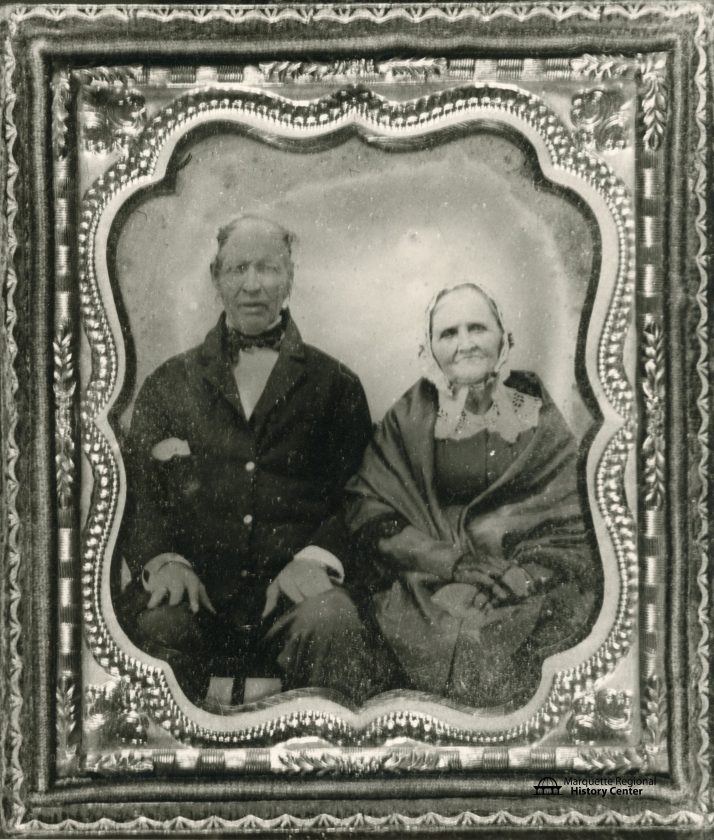Basil Bishop: Marquette’s War of 1812 veteran

Basil and Eliza Bishop are pictured. (Photo courtesy of the Marquette Regional History Center)
MARQUETTE — June 18 marks the 210th anniversary of the beginning of the War of 1812, sometimes called the “Second War of Independence.” Disagreements over territorial expansion in North America and British support for indigenous tribes who opposed U.S. colonial expansion led to the conflict between the United States of America and the United Kingdom along with indigenous allies on both sides.
Peace terms were agreed in December 1814, with the ratification of the Treaty of Ghent officially ending the war on 17 February 1815. The treaty returned the US-Canadian border to its pre-war boundary, while the indigenous nations were mostly displaced from their lands, and Spain lost land in West Florida to the United States.
Basil Bishop is the only known veteran from the War of 1812 buried in Marquette. He was born in Vermont just west of Lake Champlain in 1789 to an old New England Puritan family. As a young man, he moved across the lake to the New York side. It was there that he built and operated a famous forge at Split Rock Falls.
Basil married Elizabeth Ann Britell (known as both Eliza and Betsey, born about 1794) around 1810. They would go on to have at least 19 children, eleven sons and eight daughters, although only seven of the children are known to have survived to adulthood. While we don’t have exact birth dates, based on the birth years, there may have been three sets of twins- at least three times there were two children born within the same year.
As mentioned earlier, Basil served in the War of 1812 but there is a question as to the length of his service. He called up as a member of the New York Militia responding to the British invasion from Canada. According to an 1857 application for compensation for the clothing and equipment used while serving, he enlisted on September 5, 1814, and served for five weeks. A separate pension application filed by his widow after his death, says he enlisted on September 9, 1814, and was discharged on September 14, 1814, having served not five weeks but only five days.
Regardless of how long he actually served, we know that Basil fought in the Battle of Plattsburgh, on the shores of Lake Champlain on September 11, 1814. The combined naval and land battle was an important American victory that saved New York from possible British invasion via the Hudson River Valley and influenced the terms of the December 1814 peace treaty which ended the war. In 2001 this military plaque was placed on his grave commemorating his service.
After his service, Basil returned to his family and business. In 1850, around the time the youngest of their surviving children reached adulthood, the couple decided to leave their old life in New York behind and move to the newly founded Marquette. They took the overland route, travelling through Ohio and Illinois, then up through Wisconsin and the Upper Peninsula. While in Ohio, they contracted the ague (possibly malaria or some other illness involving fever and shivering) from which they would suffer for the rest of their lives.
Basil wrote of his arrival in Marquette on May 1, 1850 “I heard of the iron Mountains on Lake Superior & that a Forge was going & I was wholly bent to Sea it & in April I Started & Reached hear the 1 day of May 1850 the next day I was on the Iron Mountains & Sea to Sea Millions upon Millions of the Richest ore I ever Saw piled up 200ft above the Laurel Maple timber land below it was the most delightfull Seane I ever experienced.”
An 1885 History of Essex County, New York (his home before he moved to Marquette) says “Basil Bishop was a somewhat eccentric character [and] was possessed of native artistic genius of no mean order.” One example of this can be found in the 1850 Census when instead of providing his real name, Basil told the census taker that his name was Beelzebub (one of the Biblical names for the Devil). He also cut his age in half, claiming to be thirty-five instead of his actual age of sixty-one. But his occupation as a bloomer and former residence of New York both correctly match Basil’s true background.
He intended to build he own forge as he had in New York, but he ended up working for Amos Harlow at his forge. Basil was effusive in his praise of Marquette and eventually persuaded four of his children and a nephew to join him here. In 1852 he wrote “it is but 2 years last july that the first blow was Struck hear & now it is quite a viledge 15 large uprite houses 95 numerous log & Small ones a forge 130 ft long a machine Shop Shingle Mill Lath Mill & grist mill all under one Roof.”
Basil’s wife Eliza died in August 1862 and is buried at Park Cemetery. Five months later, in January 1863, he married a 50-year-old widow, Lydia Critchfield. Basil himself died in September 1865 at the age of 76 and was buried next to Eliza. After his death, Lydia moved to Baraga, Michigan where she was living when she applied for Basil’s military pension. It appears that Lydia died in Baraga in the mid-1890s.
Editor’s note: Appreciation is given to Tyler Tichelaar for his research on the Bishops (his fourth great-grandparents).




